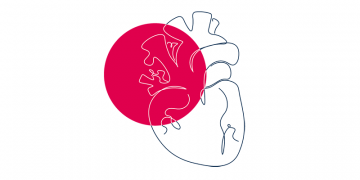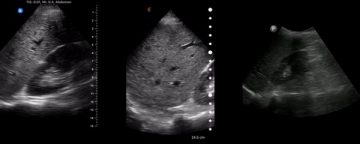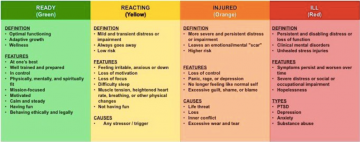By Drs. Christopher Cheung, Kenneth Gin, Jason Andrade on February 10, 2021
Patients with persistent AF, less symptomatic and/or older patients, and those with prior anti-arrhythmic failure are best managed with a rate control strategy. The EAST-AFNET 4 study is a practice-changing trial, and strongly supports the role of early rhythm control in patients with newly-diagnosed AF.
By Dr. Jennifer Russel & Françoise Mathieu MEd RP on November 18, 2020
A few weeks into the COVID-19 crisis and as a psychiatrist working in a tertiary care hospital, while homeschooling my two boys, I had a strong awareness that I needed to really work to keep myself healthy in a way that I have never felt before to make sure I was able to survive this crisis. I needed to grab my psychological PPE.
By Drs. Philip Lee and Stefanie Falz Mclellan on September 30, 2020
The integration of point of care ultrasound (PoCUS) in the emergency department workflow is not always easy, and these challenges have been amplified in the time of COVID-19. The COVID-19 pandemic has led to an increased interest in the use of handheld ultrasound devices as they simplify infection control procedures and take up little space in emergency rooms crowded with critical care equipment.
By Omid Kiamanesh, MD, FRCPC on August 26, 2020
Despite intensive lowering of LDL-C using lipid-modifying therapy, residual ASCVD risk persists, particularly in those with hypertriglyceridemia. Icosapent ethyl has been shown to reduce residual ASCVD risk and cardiovascular death in select patients with hypertriglyceridemia while on statin therapy.
By Dr. Joanna Cheek on August 5, 2020
It’s not easy to train in new skills to support our mental health when the race has already begun. We are all going to cycle out of the green zone many times, regardless of our practice of self-care. We need each other right now to provide peer support to help each of us notice when we’re moving to the right of the stress continuum and pause or pace ourselves so we can complete this marathon together.
By Drs. Lawrence Chow and Rose Hatala on May 6, 2020
In the era of the COVID-19 pandemic, our most vulnerable patients (the elderly and those with chronic illnesses) are disproportionately at the highest risk of mortality. In this difficult and chaotic time, it’s more important than ever that we maintain a humanistic approach to care. This involves keeping the patient, and their values and preferences, front and center in our care.
By Tandi Wilkinson MD CCFP-EM on April 1, 2020
I conducted a study examining effective peer support in rural Canadian physicians. (Spoiler alert: those who have had good peer support say it is essential to their career in medicine.) Here is what I am doing now to ensure I, and my team, can manage through this unprecedented time at work.
By Dr. Janet McKeown on March 11, 2020
Government Assistance: Health Resources and Forms tool has helped me understand assistance with a more organized approach. It has helped me access information quickly and it has helped me be more knowledgeable about billing provincially, federally and privately. It is also an efficient tool to use in a teaching environment to help learners better understand government assistance.
By Dr. Dan Bilsker on January 8, 2020
It is well-known that men die on average 3-4 years before women – but why? We identified three main factors contributing to Years of Life Lost by men compared to women: cardiovascular disease, suicide, and motor vehicle accidents. As a psychologist, I was intrigued by the substantial contribution of suicide.
By Dr. Lisa Nakajima on December 4, 2019
One of the risks of IUD insertion includes perforation of the uterus. Although uterine perforation is relatively uncommon and often does not cause long-term harm, it does increase the risk of unplanned pregnancy and often requires surgery. I have chosen to use endometrial aspirators that are commonly used for endometrial biopsy sampling as a sound for IUD insertions, instead of the traditional metal sounds.
By Dr. Tahmeena Ali on August 21, 2019
I now ask all patients, young and old, new to my practice and established for years, male and female, to complete an ACEs questionnaire in my clinic. I garner a new level of respect for my patients’ resilience and for the ongoing turmoil many of my young patients face. I make finding supports for these young vulnerable patients one of my top priorities—as important as a referral to a specialist or for diagnostic imaging.
By Dr. Miguel Imperial on July 30, 2019
Once I diagnose a patient with CLM based on a compatible travel history and characteristic serpiginous rash, I continue to treat the itch and inflammatory symptoms symptomatically if indicated, but I am able to much more readily offer systemic therapy with ivermectin since it no longer requires a Health Canada Special Access application.
By Dr. Daniel Ngui on June 12, 2019
The Physician Practice Enhancement Program Assessment is highly educational and it helps physicians enhance the quality of their patient care through a peer review. It provides valuable feedback and creates opportunities to guide professional development and lifelong learning.
By Dr. Joanna Cheek on May 8, 2019
View personality disorder symptoms as important treatment targets in themselves. Be curious about each patient’s story, validate PD symptoms as coping mechanisms, focus on collaborative problem solving, set proactive regular visits, and also be mindful of your own emotional reactions providing compassion and empathy while setting clear boundaries.
By Dr. Darly Wile on April 3, 2019
What I have found is that while it can sometimes be assumed that motor problems are the patient’s “biggest problem”, this is often not the case; instead, I now make a point of asking the patient, and their family directly: “What is the biggest problem for you right now?”
By Dr. Muxin (Max) Sun on March 6, 2019
I have decreased my frequency of giving steroid injections for decreasing pain of osteoarthritic knees. I educate patients on evidence, placebo effects and risks. I recommend less invasive therapies including physiotherapy, exercise (quadriceps and hip abductor strengthening, Tai Chi), hot compress, antiinflammatory creams, weight loss, TENS machine, orthopedic & orthotic devices, etc.
By Mark W. Hull MD MHSc on November 13, 2018
Over the last five years, on an ongoing basis, we have seen new HIV infections occurring in young gay, bisexual and other men who have sex with men (MSM). The majority of these individuals had had a prior negative HIV test within the last year, or were presenting with signs or symptoms supportive of an acute HIV infection, suggesting recent exposure and transmission of HIV infection, highlighting the need for novel HIV prevention strategies.
By Michelle C. Danda, RN, BN on October 10, 2018
I realized that engagement is paramount when working with an ambivalent patient, because the change that they want to make is often important in their life, even if the clinician views it as a problem behavior. Motivational interviewing education has been shown to improve patient alliance and treatment adherence.
By Dr. Carol-Ann Saari on September 5, 2018
In the general population, approximately 75% of Canadians will report having experienced an adverse and potentially traumatic experience in their lifetime, with 9.2% meeting criteria for PTSD. We have to become trauma informed. Trauma informed practice (TIP) is a way of providing services that recognizes the need for physical and emotional safety, choice and control in decisions affecting one’s treatment and an environment where patients do not experience further traumatization.
By Dr. Colleen Varcoe and Dr. Heather Smith on August 15, 2018
Health equity-oriented care is now part of my daily practice; the tools created with, and provided by, the EQUIP study have helped to make health care inequity an issue that I can screen for and offer options for management.
By Drs. Terence Yung and Tony Wan on July 24, 2018
For those who had an elective hip or knee arthroplasty who have no other risk factors for VTE, after initial 5 days of DVT prophylaxis with rivaroxaban 10mg a day, I complete the remaining DVT prophylaxis with aspirin 81mg once daily for an additional 30 days for hip arthroplasty and 9 days for knee arthroplasty. Those who already were on once-daily 81mg aspirin prior to surgery will receive 162mg aspirin once daily instead in this period.
By Dr. Min S. Phang, MRCP, FRCPC and Stacey Miller, PT on June 13, 2018
I now refer all children with cerebral palsy, or suspected cerebral palsy, to the Child Health BC Hip Surveillance Program. Information about the program is available at www.childhealthbc.ca/hips, including a referral form for physicians. The incidence of hip dislocations can be significantly reduced!
By Dr. Vanessa Brcic and Dr. Devon Christie on April 18, 2018
What changed our practice was a fundamental recognition of trauma as a determinant of health, and furthermore, that PTSD is only the tip of the iceberg when it comes to trauma. Much lies under the surface for our patients.
By Dr. Vincent Hanlon on March 14, 2018
Mindfulness is the awareness that emerges through paying attention to the unfolding of experience moment by moment. This paying attention is done on purpose, in the present moment, and it’s non-judgmental.
By Dr. Duncan Etches on February 21, 2018
In summary, in place of pattern or algorithm driven medicine, clinical experience and ability to determine what is best for our patient lies at the heart of the art of medicine.
By Doson Chua, PharmD, FCSHP, BCPS(AQ) and Dr. Mustafa Toma on January 10, 2018
Sacubitril/valsartan is the first in class of ARNI and has proven its superiority in reducing mortality and morbidity in HFrEF as compared to the use of ACEI. Sacubitril/valsartan should be considered in patients who are symptomatic despite optimal or maximally tolerated guideline-driven HF therapies consisting of a beta blocker, ACEI/ARB and MRA. Monitoring of patients on sacubitril/valsartan is similar to ACEI.
By Dr. David Topps on November 29, 2017
Ever been frustrated by the number of passwords you have to keep track of in your daily life as a professional? At one time, you might have only a few – some simple ones for unimportant sites, some stronger ones and perhaps a really good one for your most important data.
By By Dr. Christy Sutherland and Emily Wagner on November 15, 2017
I no longer offer rapid methadone tapers to my patients. Buprenorphine/naloxone is now recommended as the first-line opioid agonist treatment for opioid use disorder in British Columbia. This is because of its superior safety profile when compared with methadone as well as an easier transition to take home dosing.
By Dr. Roberto Leon on November 1, 2017
I came across a publication in the British Medical Journal by Sarah A. Schoeman: Assessment of best single sample for finding chlamydia in women with and without symptoms: a diagnostic test study. Participants took a vaginal swab before a routine gynecological exam, and clinicians then took an endocervical swab during examination.
By Dr. Jennifer Robinson on October 18, 2017
MOVE an injury: Movement, not rest. Options: offer other options for cross training. Vary rehabilitation with strength, balance and agility drills. Ease back to activity early for emotional strength.





























Recent Comments